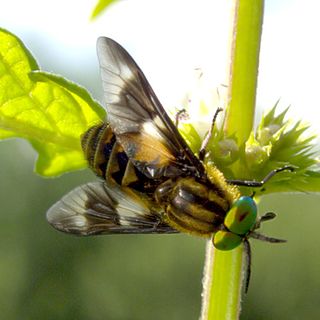Related Research Articles

Equidae is the taxonomic family of horses and related animals, including the extant horses, asses, and zebras, and many other species known only from fossils. All extant species are in the genus Equus, which originated in North America. Equidae belongs to the order Perissodactyla, which includes the extant tapirs and rhinoceros, and several extinct families.
Genus is a taxonomic rank used in the biological classification of living and fossil organisms as well as viruses. In the hierarchy of biological classification, genus comes above species and below family. In binomial nomenclature, the genus name forms the first part of the binomial species name for each species within the genus.

In taxonomy, binomial nomenclature, also called binominal nomenclature or binary nomenclature, is a formal system of naming species of living things by giving each a name composed of two parts, both of which use Latin grammatical forms, although they can be based on words from other languages. Such a name is called a binomial name, a binomen, binominal name or a scientific name; more informally it is also historically called a Latin name.

The lagomorphs are the members of the taxonomic order Lagomorpha, of which there are two living families: the Leporidae and the Ochotonidae (pikas). The name of the order is derived from the Ancient Greek lagos + morphē. There are 110 recent species of lagomorph of which 109 are extant, including 34 species of pika, 42 species of rabbit, and 33 species of hare.

Vespertilionidae is a family of microbats, of the order Chiroptera, flying, insect-eating mammals variously described as the common, vesper, or simple nosed bats. The vespertilionid family is the most diverse and widely distributed of bat families, specialised in many forms to occupy a range of habitats and ecological circumstances, and it is frequently observed or the subject of research. The facial features of the species are often simple, as they mainly rely on vocally emitted echolocation. The tails of the species are enclosed by the lower flight membranes between the legs. Over 300 species are distributed all over the world, on every continent except Antarctica. It owes its name to the genus Vespertilio, which takes its name from a word for bat, vespertilio, derived from the Latin term vesper meaning 'evening'; they are termed "evening bats" and were once referred to as "evening birds".

Ovenbirds or furnariids are a large family of small suboscine passerine birds found from Mexico and Central to southern South America. They form the family Furnariidae. This is a large family containing around 315 species and 70 genera. The ovenbird, which breeds in North America, is not a furnariid – rather it is a distantly related bird of the wood warbler family, Parulidae.
In biology, a monotypic taxon is a taxonomic group (taxon) that contains only one immediately subordinate taxon. A monotypic species is one that does not include subspecies or smaller, infraspecific taxa. In the case of genera, the term "unispecific" or "monospecific" is sometimes preferred. In botanical nomenclature, a monotypic genus is a genus in the special case where a genus and a single species are simultaneously described. In contrast an oligotypic taxon contains more than one but only a very few subordinate taxa.

Tragelaphus is a genus of medium- to large-sized spiral-horned antelopes. It contains several species of bovine, all of which are relatively antelope-like. Species in this genus tend to be large sized, lightly built, have long necks and considerable sexual dimorphism. Elands, including the common eland, are embedded within this genus meaning that Taurotragus must be subsumed into Tragelaphus to avoid paraphyly. Alternatively, Taurotragus could be maintained as a separate genus, if the nyala and the lesser kudu are relocated to their own monospecific genera: respectively, Nyala and Ammelaphus. Other generic synonyms include Strepsiceros and Boocercus. The name "Tragelaphus" comes from the mythical tragelaph.

The Nectriaceae comprise a family of fungi in the order Hypocreales. It was circumscribed by brothers Charles and Louis René Tulasne in 1865.
Cylindrocladium peruvianum is a fungal plant pathogen.
Calonectria pteridis is a fungal plant pathogen. It is native to North America. It exclusively lives on the leaves of the Polystichum adiantiforme, Dryopteris normalis and of Nephrolepis exaltata plants. The name is synonymous with Cylindrocladium pteridis.

Pytilia is a genus of small brightly coloured seed-eating birds in the family Estrildidae. They are distributed across Africa.

Zaniolepis is a genus of scorpaeniform fish native to the eastern Pacific Ocean. Z. frenata that was a source of food to the Native American inhabitants of San Nicolas Island off the coast of southern California, United States during the Middle Holocene.

Ficus pleurocarpa, commonly known as the banana fig, karpe fig or gabi fig, is a fig that is endemic to the wet tropical rainforests of northeastern Queensland, Australia. It has characteristic ribbed orange and red cylindrical syconia. It begins life as a hemiepiphyte, later becoming a tree up to 25 m (82 ft) tall. F. pleurocarpa is one of the few figs known to be pollinated by more than one species of fig wasp.

Superfamily Tabanoidea are insects in the order Diptera.
C. theae can refer to a few different species (below). The specific epithet theae refers to tea, and many of the below are pathogens of the tea plant.
Campocraspedon is a genus of ichneumonid wasp in the insect order Hymenoptera. It comprises six species.
Gliocephalotrichum simplex is a species of fungus belonging to the family Nectriaceae.